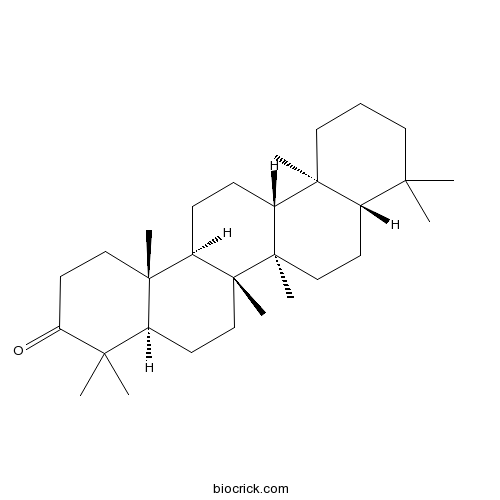TetrahymanoneCAS# 17822-06-9 |

Quality Control & MSDS
3D structure
Package In Stock
Number of papers citing our products

| Cas No. | 17822-06-9 | SDF | Download SDF |
| PubChem ID | 101124569 | Appearance | Powder |
| Formula | C30H50O | M.Wt | 426.72 |
| Type of Compound | Triterpenoids | Storage | Desiccate at -20°C |
| Solubility | Soluble in Chloroform,Dichloromethane,Ethyl Acetate,DMSO,Acetone,etc. | ||
| Chemical Name | (4aR,6aR,6aR,6bR,8aS,12aS,14aR,14bR)-4,4,6a,6b,9,9,12a,14b-octamethyl-2,4a,5,6,6a,7,8,8a,10,11,12,13,14,14a-tetradecahydro-1H-picen-3-one | ||
| SMILES | CC1(CCCC2(C1CCC3(C2CCC4C3(CCC5C4(CCC(=O)C5(C)C)C)C)C)C)C | ||
| Standard InChIKey | IMOCDWIUBNNKCU-KYSSMBTOSA-N | ||
| Standard InChI | InChI=1S/C30H50O/c1-25(2)15-9-16-27(5)20(25)12-18-29(7)22(27)10-11-23-28(6)17-14-24(31)26(3,4)21(28)13-19-30(23,29)8/h20-23H,9-19H2,1-8H3/t20-,21-,22+,23+,27-,28-,29+,30+/m0/s1 | ||
| General tips | For obtaining a higher solubility , please warm the tube at 37 ℃ and shake it in the ultrasonic bath for a while.Stock solution can be stored below -20℃ for several months. We recommend that you prepare and use the solution on the same day. However, if the test schedule requires, the stock solutions can be prepared in advance, and the stock solution must be sealed and stored below -20℃. In general, the stock solution can be kept for several months. Before use, we recommend that you leave the vial at room temperature for at least an hour before opening it. |
||
| About Packaging | 1. The packaging of the product may be reversed during transportation, cause the high purity compounds to adhere to the neck or cap of the vial.Take the vail out of its packaging and shake gently until the compounds fall to the bottom of the vial. 2. For liquid products, please centrifuge at 500xg to gather the liquid to the bottom of the vial. 3. Try to avoid loss or contamination during the experiment. |
||
| Shipping Condition | Packaging according to customer requirements(5mg, 10mg, 20mg and more). Ship via FedEx, DHL, UPS, EMS or other couriers with RT, or blue ice upon request. | ||
| Description | Tetrahymanone is a natural product from Bradyrhizobium japonicum. |
| Structure Identification | Sci Total Environ. 2014 Feb 1;470-471:180-92Occurrence and sources of polar lipid tracers in sediments from the Shatt al-Arab River of Iraq and the northwestern Arabian Gulf.[Pubmed: 24140688 ]
|

Tetrahymanone Dilution Calculator

Tetrahymanone Molarity Calculator
| 1 mg | 5 mg | 10 mg | 20 mg | 25 mg | |
| 1 mM | 2.3435 mL | 11.7173 mL | 23.4346 mL | 46.8691 mL | 58.5864 mL |
| 5 mM | 0.4687 mL | 2.3435 mL | 4.6869 mL | 9.3738 mL | 11.7173 mL |
| 10 mM | 0.2343 mL | 1.1717 mL | 2.3435 mL | 4.6869 mL | 5.8586 mL |
| 50 mM | 0.0469 mL | 0.2343 mL | 0.4687 mL | 0.9374 mL | 1.1717 mL |
| 100 mM | 0.0234 mL | 0.1172 mL | 0.2343 mL | 0.4687 mL | 0.5859 mL |
| * Note: If you are in the process of experiment, it's necessary to make the dilution ratios of the samples. The dilution data above is only for reference. Normally, it's can get a better solubility within lower of Concentrations. | |||||

Calcutta University

University of Minnesota

University of Maryland School of Medicine

University of Illinois at Chicago

The Ohio State University

University of Zurich

Harvard University

Colorado State University

Auburn University

Yale University

Worcester Polytechnic Institute

Washington State University

Stanford University

University of Leipzig

Universidade da Beira Interior

The Institute of Cancer Research

Heidelberg University

University of Amsterdam

University of Auckland

TsingHua University

The University of Michigan

Miami University

DRURY University

Jilin University

Fudan University

Wuhan University

Sun Yat-sen University

Universite de Paris

Deemed University

Auckland University

The University of Tokyo

Korea University
- Linderone
Catalog No.:BCN1133
CAS No.:1782-79-2
- Hardwickiic acid
Catalog No.:BCN1132
CAS No.:1782-65-6
- 6,7,4'-Trihydroxyisoflavone
Catalog No.:BCN2910
CAS No.:17817-31-1
- H-Asp-OMe
Catalog No.:BCC2884
CAS No.:17812-32-7
- 3-Deoxyzinnolide
Catalog No.:BCN4799
CAS No.:17811-32-4
- Bacopasaponin C
Catalog No.:BCC8124
CAS No.:178064-13-6
- Nociceptin (1-13)NH2
Catalog No.:BCC5749
CAS No.:178064-02-3
- Aescigenin
Catalog No.:BCC8293
CAS No.:17806-68-7
- Fmoc-D-Phe(4-NO2)-OH
Catalog No.:BCC3278
CAS No.:177966-63-1
- Allopurinol Sodium
Catalog No.:BCC4886
CAS No.:17795-21-0
- Sauchinone
Catalog No.:BCN2299
CAS No.:177931-17-8
- Clematichinenoside C
Catalog No.:BCN7850
CAS No.:177912-24-2
- Calystegine B3
Catalog No.:BCN1880
CAS No.:178231-95-3
- Orphanin FQ (1-11)
Catalog No.:BCC6085
CAS No.:178249-41-7
- Nociceptin (1-7)
Catalog No.:BCC5738
CAS No.:178249-42-8
- H-D-Asp-OH
Catalog No.:BCC2894
CAS No.:1783-96-6
- 12-Hydroxy-6-epi-albrassitriol
Catalog No.:BCN7460
CAS No.:178330-78-4
- Tos-Arg-OMe.HCl
Catalog No.:BCC2874
CAS No.:1784-03-8
- AR-R 17779 hydrochloride
Catalog No.:BCC7827
CAS No.:178419-42-6
- Agrostophyllidin
Catalog No.:BCN3598
CAS No.:178439-50-4
- 6-epi-Albrassitriol
Catalog No.:BCN7342
CAS No.:178456-58-1
- Vitexin -4''-O-glucoside
Catalog No.:BCN3054
CAS No.:178468-00-3
- Hoechst 33342 analog
Catalog No.:BCC1630
CAS No.:178481-68-0
- Prilocaine hydrochloride
Catalog No.:BCC4288
CAS No.:1786-81-8
Occurrence and sources of polar lipid tracers in sediments from the Shatt al-Arab River of Iraq and the northwestern Arabian Gulf.[Pubmed:24140688]
Sci Total Environ. 2014 Feb 1;470-471:180-92.
Shallow surface sediment samples from the southern part of the Shatt al-Arab River estuary of Iraq and the northwestern Arabian Gulf were analyzed for polar lipid compounds including n-alkanoic acids, n-alkanols, steroids and triterpenoids. The results showed that the n-alkanoic acids, methyl n-alkanoates and n-alkanols typically ranged from C12 to C32 with total concentrations of 3.2 to 108.2 mug g(-1)dwt sample, from C12 to C30 with totals of 1.1 to 18.9 mug g(-1)dwt sample, and from C14 to C32 at 1.8 to 112.6 mug g(-1)dwt sample, respectively. Steroids and triterpenoids were detected and included stenols, stanols, stenones, stanones, tetrahymanol, Tetrahymanone and extended betabeta-hopanes. The total steroid concentrations ranged from 2.8 to 78.4 mug g(-1)dwt sample, whereas the triterpenoids varied from 0.05 to 7.6 mug g(-1)dwt sample. The simple regression analysis of the results and the spatial distribution patterns of the identified organic tracers indicated that the inter-compound relationships were related mainly to their major sources. Cluster analysis and principal component analysis (PCA) of data set showed that the sampling sites are similar. These sources were allochthonous (terrestrial vegetation), autochthonous (plankton residues and bacteria in the sediments) and anthropogenic (sewage and petroleum).


